Almost every Shabbos, we are faced with questions about muktzah:
- I accidentally left my cell phone on my bed. Can I move it off?
- Can I pick up a coin the fell on the floor on Shabbos?
- Can I move my dining room table if I noticed there was a pen left on it from before Shabbos?
The halachos of muktza can get pretty confusing, so to clarify, we put together this handy Muktzah chart which can guide you through the decision-making process.
This chart was based on a series of shiurim by Rabbi Eliezer Krohn and the chart has been reviewed by Rabbi Krohn for accuracy before publishing.
For a more detailed explanation of these halachos, you can listen to the original series of shiurim at these links: Part 1, Part 2, Part 3, Part 4, Part 5, Part 6, Part 7, and Review.
| Example | Category | Details |
|---|---|---|
 |
Not Muktzah |
|
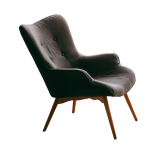 |
Kli Shemilachto L’heter |
|
 |
Kli Shemilachto L’Issur |
|
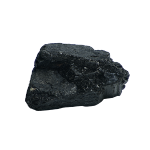 |
Muktzah Machmas Gufo |
|
 |
Muktzah Machmas Chesron Kis |
|
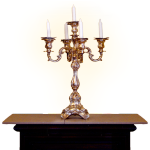 |
Bosis |
|
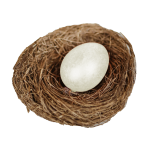 |
Nolad |
|
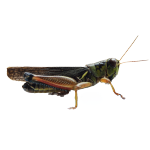 |
Graf Shel Re’i |
|
Once something is muktzah during bein hashmashos17 it remains muktzah for the rest of Shabbos even if something changes due to human intervention (but if it changed through natural intervention, then it can lose its muktzah status).18
If something falls into multiple categories (eg. cell phone which is both a kli shemilachto l’issur as well as muktzah machmas chesron kis) then it takes on the restrictions of both categories. (However, if it’s a Graf Shel Re’i, then it’s fine to move
What it means: Moving the muktzah item with a different part of your body (not your hand) in a weird way
When can you do it?
- Only do Tiltul B’Gufo if you really need to (eg. Don’t try to save a penny or don’t kick around a rock for no reason).
- If something is the normal way to use the item, then it doesn’t count as Tiltul B’Gufo
(eg. moving a broken shoe by wearing it on your foot, or carrying money in a money belt).
Examples of permitted Tiltul B’Gufo: Kicking a dollar bill somewhere so that it wont be lost, or walking through bushes and pushing them aside with your elbows so they wont be in your way.
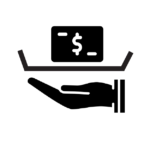 Tiltul Min Hatzad:
Tiltul Min Hatzad:
What it means: Moving the muktzah item using your hands but without touching it directly
When can you do it?
- ONLY permitted when you are doing it for the purpose of the non-muktzah item (eg. you can move a bowl containing a penny only if it’s to
use the bowl, not to save the penny). - Ni’ur (shaking off) is preferable (eg. if a phone was left on your bed, you should preferably shake the blanket to get it off).
- Better not to do Tiltul Min HaTzad all Shabbos long (eg. don’t keep muktzah items in your fridge door).
Note: Check if the bottom item is a Bosis before moving it.
FOOTNOTES:
- A “kli” is hard to define. Generally, means it is an object which has a function (as opposed to something like a rock which has no function).
- See footnote 1.
- You should only use a kli shemelachto l’issur if you don’t have regular kli available.
- It’s a machlokes if something like moving a fan blowing on you, or moving a blaring alarm clock, is considered l’tzorech mikomo. We pasken that it’s OK to move. (But better not to move a lamp because it may be considered like fire.) It’s also a machlokes if moving a mess is considered l’tzorech mikomo (eg. crayons on the floor – you can walk around it but you’d rather not have it there). So don’t move it.
- When done, you can put it back down where it belongs (you don’t need to drop it immediately),
- See footnote 1.
- If a non-owner left the muktzah item there, then it does not become a Bosis if left there (eg. a young child cannot make something a Bosis if it belongs to their parents). A teen is considered to own their own items (even if their parents technically own them). A guest is considered to own the things they are using while staying in your house.
- This assumes that the muktzah item was there during bein hashmashos (the period between sunset and about 50-60 min after sunset) – even if it was moved off later. If a muktzah item was placed on top of a non-muktzah item in the middle of Shabbos, then it’s machlokes whether it becomes a Bosis. To be safe, don’t do Tiltul Min HaTzad but you can do ni’ur (eg. if a child left a hammer on your bed on Shabbos, shake it off with the blanket).
- If you meant to move the muktzah item before Shabbos but you forgot to move it, then the bottom item does not become a Bosis. (eg. left purse on your bed). However, this does not work if you left the muktzah item in its set place where it’s always kept.
- (a) If the Bosis is supporting BOTH a muktzah item AND a non-muktzah item, it becomes a Bosis to whichever is more expensive. (eg. if a drawer is supporting both a shaver and socks, then it becomes a Bosis to the shaver).
(b) But if the non-muktzah item is necessary for Shabbos then that is considered the main item even if it’s less expensive (eg. If a drawer is supporting both a bentscher and a $100 bill, the drawer does not become a Bosis because the bentscher is needed for Shabbos).
(c) If the muktzah item is insignificant then it doesn’t make the bottom item become a Bosis because it’s bateil [nullified] (eg. If you left a penny in a dish, then the bowl does not become a Bosis. However, note that the penny is still muktzah.)
(d) If the muktzah item is in a side section of another item, then it doesn’t create a Bosis. Eg. if you leave a muktzah item in a non-removable drawer in your dresser, then only that drawer becomes a Bosis – the rest of the dresser does not. If the drawer is removable, however, then the whole dresser does become a Bosis. - This Bosis status extends even farther down to lower objects. For example, a flame is muktzah, so ALL of the supporting objects below it become a Bosis (i.e. the candle, the candlestick, the tray, the table it’s resting on, etc.)
- Example #1: If a penny is left in a bowl, the bowl does not become a Bosis because the penny is insignificant (See footnote #12). So you can move the bowl, but if you do, you will be indirectly moving the penny (Tiltul Min HaTzad) which is only permissible for the purpose of the non-muktzah item. (So you can move the bowl for the sake of using the bowl but not for the sake of saving the penny.)Example #2: Pistachio shells left on a plate make the plate a Bosis. Now both the shells and the plate are muktzah machmas gufo. To solve the plate’s Bosis issue, you can put a non-muktzah item onto the plate so that now the plate is supporting both a muktzah and non-muktzah item, so that the plate isn’t a Bosis any more (See footnote #6). But if you would move the plate, you would be doing Tiltul Min HaTzad to the pistachio shells. This is permitted because you are moving it for the sake of your table being clean (as opposed to the shells, which you don’t care about). When you get to the garbage can, do ni’ur (shake the shells into the can).
- “Spoiled on Shabbos” means that it was fit for human consumption before Shabbos, but now on Shabbos it became only fit for animal consumption.
- Assuming that the child can still use the toy for a different function (otherwise it would become muktzah machmas gufo).
- You can only move a Graf Shel Re’i if it’s in a place where you are actually spending time (ie. not the basement or attic where no one will spend time on Shabbos anyway).
- If possible, it’s better to move a Graf Shel Re’i indirectly (i.e. not with your hands).
- “Bein Hashmashos” refers to the time period between sunset and about 50-60 min after sunset.
- For example, expensive paper at the onset of Shabbos is muktzah machmas chesron kis, and even if a child rips the paper on Shabbos (i.e. human intervention), it remains muktzah. On the other hand: An unripe banana at the onset of Shabbos is muktzah machmas gufo, but if it ripens over the course of Shabbos (i.e. changes by natural means) then it becomes not muktzah any more.
- Wearing a coat which has car keys left in the coat pocket is considered Tiltul Min HaTzad to the keys because you are moving it in a normal way (wearing the coat) without actually touching it with your hands directly (as opposed to Tiltul B’Gufo which means moving it in a weird way).

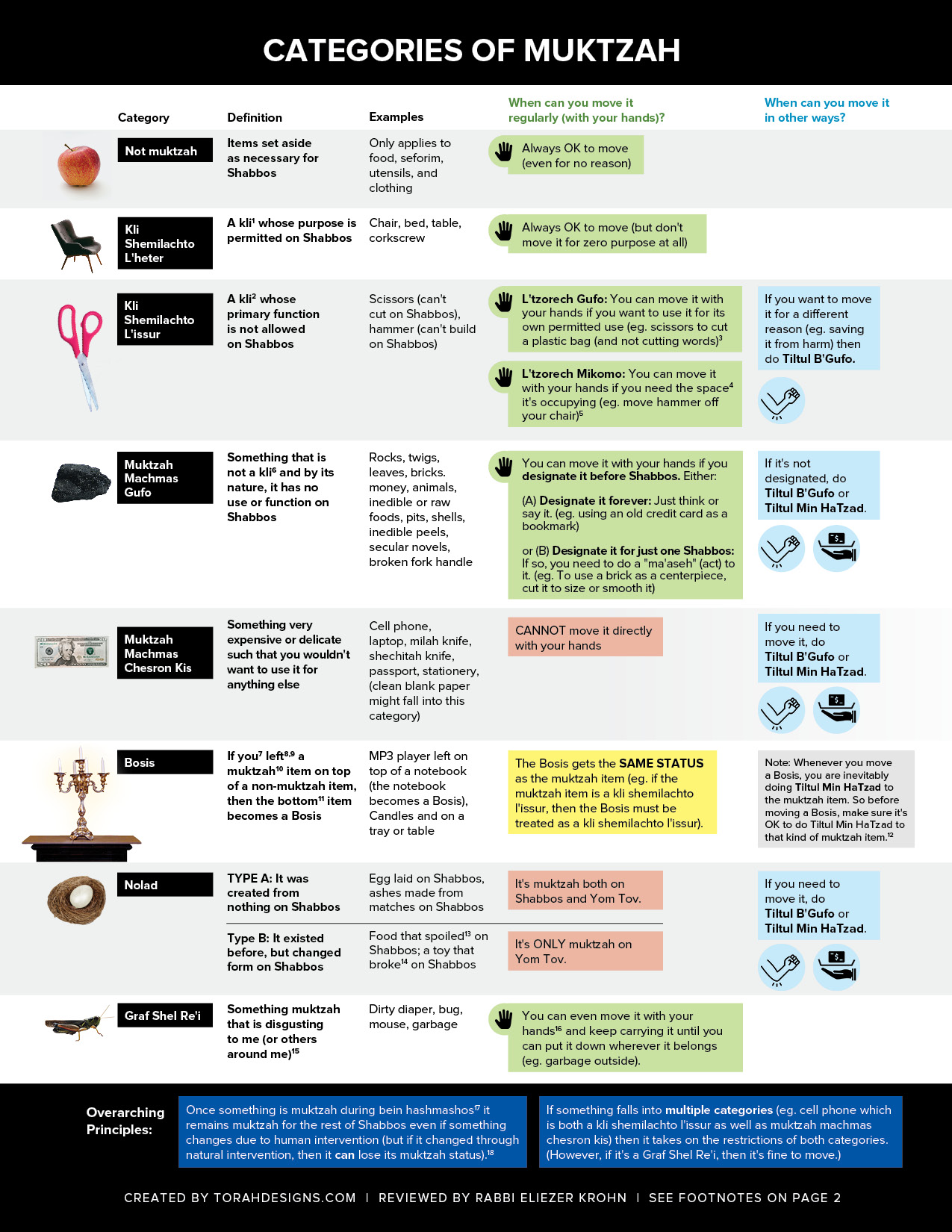
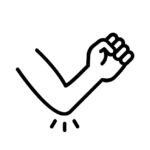 Tiltul B’Gufo:
Tiltul B’Gufo:
Leave A Comment